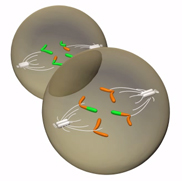
meiosis
Meiosis is a type of cell division that reduces the number of chromosomes in the parent cell by half and produces four gamete cells. This process is required to produce egg and sperm cells for sexual reproduction. During reproduction, when the sperm and egg unite to form a single cell, the number of chromosomes is restored in the offspring.
Meiosis begins with a parent cell that is diploid, meaning it has two copies of each chromosome. The parent cell undergoes one round of DNA replication followed by two separate cycles of nuclear division. The process results in four daughter cells that are haploid, which means they contain half the number of chromosomes of the diploid parent cell.
Meiosis has both similarities to and differences from mitosis, which is a cell division process in which a parent cell produces two identical daughter cells. Meiosis begins following one round of DNA replication in cells in the male or female sex organs. The process is split into meiosis I and meiosis II, and both meiotic divisions have multiple phases. Meiosis I is a type of cell division unique to germ cells, while meiosis II is similar to mitosis.
Meiosis I, the first meiotic division, begins with prophase I. During prophase I, the complex of DNA and protein known as chromatin condenses to form chromosomes. The pairs of replicated chromosomes are known as sister chromatids, and they remain joined at a central point called the centromere. A large structure called the meiotic spindle also forms from long proteins called microtubules on each side, or pole, of the cell. Between prophase I and metaphase I, the pairs of homologous chromosome form tetrads. Within the tetrad, any pair of chromatid arms can overlap and fuse in a process called crossing-over or recombination. Recombination is a process that breaks, recombines and rejoins sections of DNA to produce new combinations of genes. In metaphase I, the homologous pairs of chromosomes align on either side of the equatorial plate. Then, in anaphase I, the spindle fibers contract and pull the homologous pairs, each with two chromatids, away from each other and toward each pole of the cell. During telophase I, the chromosomes are enclosed in nuclei. The cell now undergoes a process called cytokinesis that divides the cytoplasm of the original cell into two daughter cells. Each daughter cell is haploid and has only one set of chromosomes, or half the total number of chromosomes of the original cell.
Meiosis II is a mitotic division of each of the haploid cells produced in meiosis I. During prophase II, the chromosomes condense, and a new set of spindle fibers forms. The chromosomes begin moving toward the equator of the cell. During metaphase II, the centromeres of the paired chromatids align along the equatorial plate in both cells. Then in anaphase II, the chromosomes separate at the centromeres. The spindle fibers pull the separated chromosomes toward each pole of the cell. Finally, during telophase II, the chromosomes are enclosed in nuclear membranes. Cytokinesis follows, dividing the cytoplasm of the two cells. At the conclusion of meiosis, there are four haploid daughter cells that go on to develop into either sperm or egg cells.
Further Exploration
Concept Links for further exploration

















